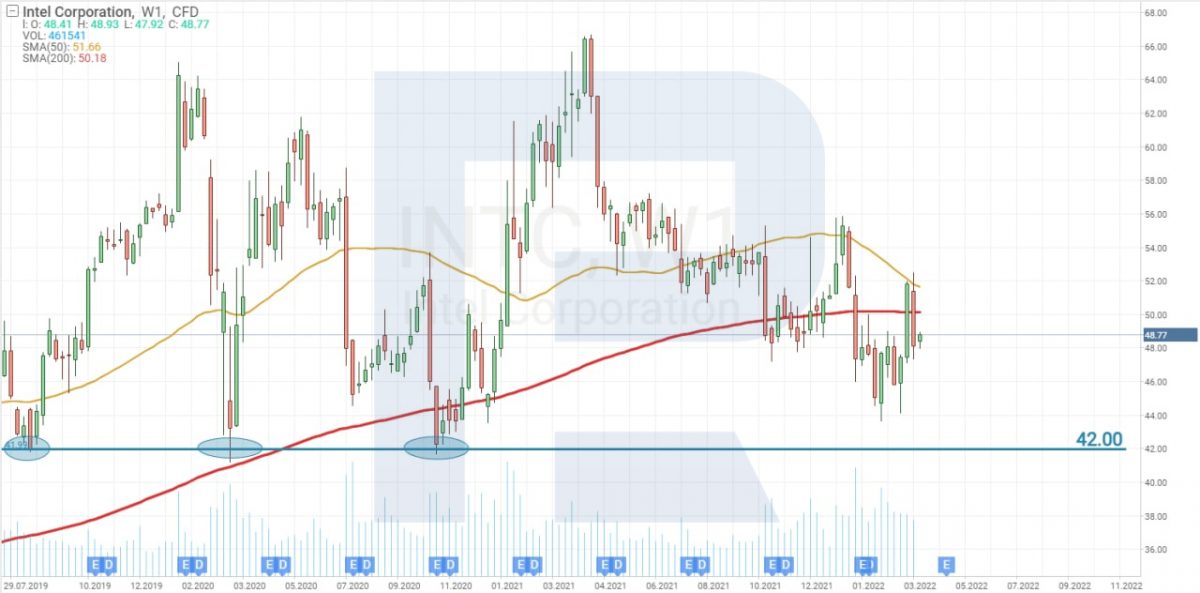Intel Shares: Long-Term Investment Analysis

6 minutes for reading
How things are going in the semiconductor market
On 29 March, Micron Technology Inc. (NASDAQ: MU), a major supplier of semiconductors, published its financial report for Q1 2022. The revenue of the company amounted to 7.79 billion USD, which is 3% more than forecast. Other results also exceeded Wall Street expectations and impressed investors.
Micron's financial report is indeed strong but it represents past performance. Market players are currently more interested in what is going to happen in the future. Hence, their attention was more drawn to the comments of the management of the corporation regarding future activities, and the situation in the market of semiconductors.
From what Micron representatives stated, we can conclude that the shortage of semiconductors will last until the end of 2022 at least, which will entail a 17.5% yearly increase in revenue and an EPS rise of 31%. Another factor influencing this growth is the increase in the prices of the company's products.
Why semiconductor prices are rising
One reason is the shortage of the neon gas that is used in microchip production. Ukraine used to satisfy about 40% of the global demand for neon, followed by Russia with almost 30%. However, if the conflict between Russia and Ukraine persists, the market might run short of neon.
For microchip makers, the situation is not disastrous yet: they have neon in stock for a medium-long term and will try to identify new suppliers, and include the additional expenses in their prices.
Normally, the rise in prices results in shrinking demand, but not in the case of semiconductors. Experts forecast that the demand for this kind of product will remain high even if prices rise.
Why semiconductors remain in demand
Semiconductors are in great demand by electric car manufacturers, and makers of 5G technology, smartphones, tablets, laptops, and PCs, alongside the scaling of data processing centres.
It is impossible for such demand for microchips to be satisfied with the currently existing production capacities and the supply issues that were created by the pandemic. Moreover, without a more or less clear perspective, the situation is not likely to improve.
And how can perspectives become clearer when Europe is in the midst of a war and China is under quarantine that was implemented in Shanghai on 29 March due to a new outbreak of COVID-19?
Offices and plants are shut down unless they are vital for the life of the city. There are no guarantees that the coronavirus will not strike in other Chinese localities, compromising supply chains.
Why Intel is increasing production
The factors named above have made large Western corporations revise their development strategies and invest in production capacities in order to become less dependent on their Asian counterparts. One such corporation is Intel Corporation (NASDAQ: INTC).
When Pat Gelsinger returned to Intel, the company focused on building new manufacturing facilities. Intel needs new production powers to satisfy constantly growing demand. The company plans to invest in building manufacturing plants in Europe for some 88 billion USD.
There will also be a plant in Germany, mainly to satisfy the demand of the car industry for microchips. There are plans to construct a research centre in France, a plant for assembling and packaging the chips in Italy, and calculation labs in Poland and Spain. Moreover, the existing Intel plant in Ireland will be further developed.
Diversification of European investments will help the company get subsidies from each interested country. For example, Italy is ready to partially finance the construction of new projects and offer discounts on electricity and payments to employees. European countries are now competing to attract Intel.
Apart from investing in Europe, the corporation is allocating 20 billion USD for two new manufacturing plants in the US. The new production powers will help Intel resume its position in the semiconductor market and at least catch up with its main rivals.
What happened to Intel’s shares this year?
In Q1 2021, the income of the company was at the level of Q1 2020, making the attitude towards the corporation more negative. Meanwhile, its competitor, Advanced Micro Devices Inc. (NASDAQ: AMD), managed to increase its income by 89% over the same timeframe.
After this quarterly failure report, Intel shares headed down and lost 35% over a year, reaching the lows of March 2020 when the pandemic made the stock market collapse.

With Intel's level of income currently approaching its pre-pandemic levels, and considering the planned investments in new manufacturing facilities, market players are becoming more positive about Intel. Over a fortnight, the shares saw an 18% growth, yet this can mainly be attributed to the generally cheerful situation in the stock market, as over the same time frame, the S&P 500 saw an 11% growth.
NVIDIA Corporation might unite with Intel
Other market players have realised this. In March, we heard that NVIDIA Corporation (NASDAQ: NVDA) might unite with Intel to make use of its manufacturing facilities and technology in the future.
Risks of investing in Intel
Disregarding any external factors that can influence Intel shares, now is the best time to evaluate the investment prospects of the stock, considering all the company's investments in production as well as its affordable stock prices.
However, bear in mind that with inflation in the US having reached its highest, breaking the record of the last 40 years, the Fed will be lifting the interest rate and cutting down on the balance. The previous increase in the rate in 2015 resulted in the S&P 500 falling by 15%. An attempt to decrease the balance back in 2018 made the index drop by 20%, and inflation at that time was under 3%.
The current situation is much more complicated: the inflation issue cannot be solved just by increasing the rate because it is partially caused by high commodity prices, not by high consumer demand. The sanctions imposed on Russia worsen the situation.
The country exports hydrocarbons and other commodities necessary for production, which also pushes prices upwards. Hence, there are plenty of reasons for US stock indices to fall, and if it happens, Intel prices will follow suit.
Conclusion
Intel management is now preparing the base for its future leadership in the semiconductor market. Intel shares can be considered as an option for a long-term investment. Still, there are certain risks, of course.
* - Past performance does not predict future returns.
The material presented and the information contained herein is for information purposes only and in no way should be considered as the provision of investment advice for the purposes of Investment Firms Law 87(I)/2017 of the Republic of Cyprus or any other form of personal advice or recommendation, which relates to certain types of transactions with certain types of financial instruments.
















 are complex instruments and come with a high
are complex instruments and come with a high  of losing
of losing  rapidly due to
rapidly due to  . 65.68% of retail investor accounts lose
. 65.68% of retail investor accounts lose  when trading
when trading  with this provider. You should consider whether you understand how CFDs work and whether you can afford to take the high
with this provider. You should consider whether you understand how CFDs work and whether you can afford to take the high